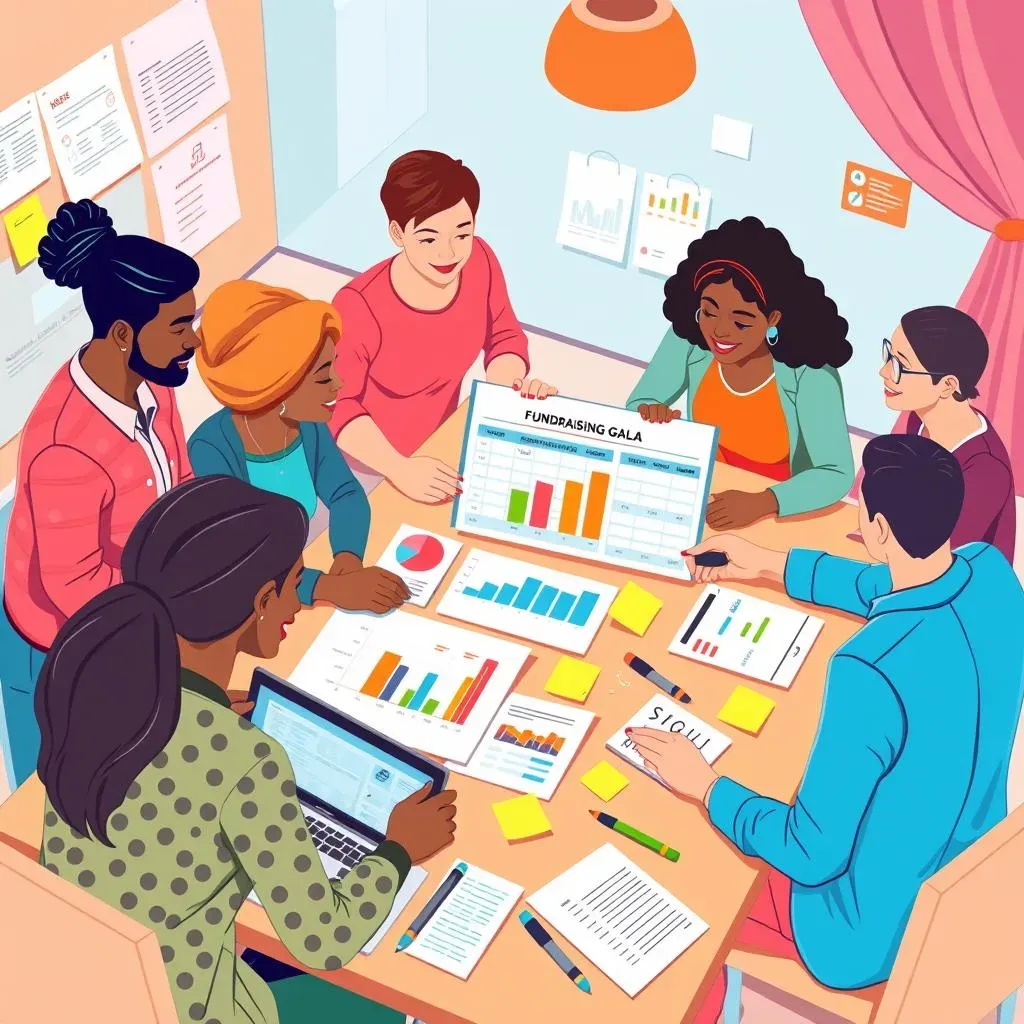Table of Contents
Dreaming of a spectacular fundraising gala that not only raises significant funds but also strengthens your community bonds? This comprehensive guide tackles the question: "How to plan a non-profit fundraising gala," offering a step-by-step roadmap to success. We'll navigate the crucial initial stages, from setting ambitious yet achievable fundraising goals and crafting a detailed budget, to assembling your dream team of volunteers and experts. Then, we'll delve into the logistical heart of the event: securing the perfect venue, crafting a captivating program, and securing vital sponsorships. Finally, we’ll cover the execution and post-event analysis, ensuring your gala leaves a lasting impression and maximizes its impact. Get ready to transform your fundraising vision into a reality, leaving no detail overlooked as you plan an unforgettable event that truly benefits your cause and inspires lasting support.
Planning Your NonProfit Fundraising Gala: Setting Goals and Budget

Planning Your NonProfit Fundraising Gala: Setting Goals and Budget
Defining Your Fundraising Goal
First things first: What's the big picture? How much money do you *really* need to raise to make a meaningful impact? Don't just throw a dart at a number. Think about specific projects your gala will fund. Maybe it's a new playground for your community center, or scholarships for deserving students. Be specific! This clarity will help you set a realistic goal and inspire potential donors. Remember, a well-defined goal is the cornerstone of a successful fundraising campaign. Check out these non-profit fundraising strategies for more ideas.
Consider breaking down your goal into smaller, more manageable chunks. This makes the overall target seem less daunting. Think of it like climbing a mountain – you don't just leap to the summit; you take it one step at a time. Celebrate each milestone reached along the way! For example, you might set smaller goals for ticket sales, sponsorships, and auction items. This phased approach helps maintain momentum and track progress effectively.
Goal | Amount | How it impacts the cause |
|---|---|---|
New playground equipment | $10,000 | Provides safe and fun outdoor space for kids |
Scholarships | $5,000 | Funds education for underprivileged youth |
Creating a Realistic Budget
Okay, you've got your fundraising goal. Now, let's get down to brass tacks: the budget. This isn't just about adding up expenses; it's about making smart financial decisions. Identify all potential costs: venue rental, catering, entertainment, decorations, marketing, etc. Be thorough! It's better to overestimate than to underestimate. Unexpected costs can quickly derail your plans, so factor in a contingency fund for those "oh no" moments. Don't forget to check out our guide on non-profit fundraising best practices for additional tips.
Explore different cost-saving strategies. Can you secure in-kind donations from local businesses? Are there volunteers who can help with setup and cleanup? Can you leverage free marketing channels like social media? Get creative! Remember, every dollar saved is a dollar that goes directly towards your cause. The more you can reduce your expenses, the more money you can raise for your organization. Think about how you can maximize the impact of your budget, and always remember to be transparent about your spending with your donors. This builds trust and shows that you're good stewards of their contributions.
Balancing Ambition and Reality
Here’s the tricky part: Finding the sweet spot between an ambitious goal and a realistic budget. You want to aim high, but you also need to be practical. If your budget is tight, consider scaling back the scope of your event. A smaller, more intimate gala might be more manageable than a large-scale affair. Remember, success isn't just about the amount of money raised; it's also about creating a memorable and impactful experience for your guests. Consider looking at best fundraising ideas for small non-profits for inspiration.
Don't be afraid to ask for help. Reach out to potential sponsors and donors early in the planning process. Their support can make all the difference in achieving your fundraising goal. Many corporations have a budget for charitable giving, and they’re often eager to partner with organizations that align with their values. A clear and well-defined proposal will significantly improve your chances of securing funding. A well-defined budget also makes it easier to demonstrate the value of your gala to potential sponsors and donors, showcasing the efficient use of funds and the significant return on their investment.
- Set a realistic fundraising goal based on past performance and current resources
- Create a detailed budget that accounts for all potential expenses
- Explore creative ways to reduce costs and increase revenue
- Secure sponsorships and donations to supplement your budget
Organizing Your NonProfit Fundraising Gala: Logistics and Team

Organizing Your NonProfit Fundraising Gala: Logistics and Team
Building Your A-Team
So, you've got the big picture – your fundraising goal and budget. Now, it's time to build your team! This isn't just about finding people; it's about assembling a group of passionate individuals with diverse skills. Think of it like building a sports team: you need players with different strengths to work together effectively. You'll need a point person for fundraising, someone who's a whiz at marketing, a logistics guru to handle the venue and vendors, and a volunteer coordinator to manage your amazing helpers. Don't forget about tech support! You'll need someone who can handle the audio-visual aspects of the event. Check out these tips on engaging donors to help you build a strong team.
Consider tapping into your existing network of volunteers and board members. They already have a vested interest in your organization and are likely eager to contribute their time and expertise. Remember, clear communication and well-defined roles are key to a smooth and efficient planning process. Regular team meetings are essential to keep everyone on the same page and address any challenges that arise. A well-organized team is the backbone of a successful event.
- Fundraising Lead
- Marketing Manager
- Logistics Coordinator
- Volunteer Coordinator
- Tech Support
Securing the Venue and Vendors
Next up: securing your venue! This is a big decision. Consider the size of your expected attendance, the ambiance you want to create, and, of course, the budget. Some venues might offer packages that include catering and other services, which can simplify the planning process. Don't just book the first place you see; shop around and compare options. Consider factors such as accessibility, parking, and overall suitability for your event. Once you've chosen your venue, it's time to start lining up vendors. Think about catering, entertainment, decorations, photographers, and any other services you might need. For more tips on planning, check out this guide on organizing a silent auction.
Remember, vendors are an important part of creating a memorable experience for your guests. Make sure to do your research and choose vendors who are reliable, professional, and aligned with your organization's values. Negotiate contracts carefully, paying close attention to the terms and conditions. Clear communication with vendors is crucial to avoid any surprises or misunderstandings on the day of the event. Start early, as popular venues and vendors often book up quickly. A well-chosen venue and reliable vendors are crucial for creating a seamless and enjoyable experience for your guests.
Vendor | Service | Cost |
|---|---|---|
Caterer | Food and beverages | $X |
Band | Live music | $Y |
Photographer | Event photography | $Z |
Executing Your NonProfit Fundraising Gala: Event Day and PostEvent

Executing Your NonProfit Fundraising Gala: Event Day and PostEvent
Making Event Day a Success
The big day is here! All your hard work is about to pay off. But don't get complacent. A well-executed event day is the culmination of meticulous planning. Make sure your team is briefed and knows their roles. Have a detailed timeline and stick to it as much as possible. Delegate tasks effectively, ensuring that everything runs smoothly. Remember that little things can make a big difference. For example, ensure that there's plenty of signage to guide guests and that the venue is well-lit and inviting. Also, have a backup plan for any potential hiccups, whether it's a technical malfunction or a last-minute vendor cancellation. Don't forget to capture the memories! Make sure you have a photographer or videographer to document the event. These visuals will be invaluable for future marketing efforts and for showing donors the impact of their generosity. For more on crafting a compelling narrative, check out our guide on effective storytelling.
Throughout the event, maintain a positive and enthusiastic attitude. Your energy will be contagious and will help create a welcoming and enjoyable atmosphere for your guests. Engage with your attendees, making them feel valued and appreciated. Take the opportunity to thank them for their support and to share updates on your organization's work. Remember, this is more than just a fundraising event; it's an opportunity to build relationships and foster a sense of community. Engage with your guests on a personal level, making them feel valued and appreciated for their support. And of course, don’t forget to have fun! This will make the experience more enjoyable for everyone involved.
Time | Activity | Responsible Person |
|---|---|---|
6:00 PM | Guest arrival and registration | Volunteer Coordinator |
7:00 PM | Dinner service | Catering Manager |
8:00 PM | Live auction | Auctioneer |
Post-Event Follow-Up: Show Your Gratitude
The gala is over, but the work isn't done yet! Show your gratitude to everyone involved. Send thank-you notes to your attendees, sponsors, volunteers, and vendors. This is a crucial step in building lasting relationships and ensuring future support. A heartfelt thank-you goes a long way. Consider personalizing your notes, mentioning something specific that you appreciated about their contribution. Also, share photos and videos from the event to keep the excitement alive. This will help you maintain momentum and build anticipation for next year's gala. For more information on keeping donors engaged, you might find this article on donor retention helpful.
Analyze the results of your fundraising efforts. How much money did you raise? What were your expenses? What worked well, and what could be improved? This post-event analysis will be invaluable in planning future events. Consider sending out a survey to your attendees to gather feedback. This will help you identify areas for improvement and ensure that your next gala is even better than the last. Remember, continuous improvement is key to long-term success. Regular evaluation and feedback allow you to refine your strategy and maximize the impact of your future fundraising initiatives. To learn more about analyzing your results, you might want to explore non-profit fundraising success stories to see what worked for others.
- Send personalized thank-you notes to all stakeholders
- Share photos and videos from the event on social media
- Analyze your fundraising results and identify areas for improvement
- Gather feedback from attendees through surveys
